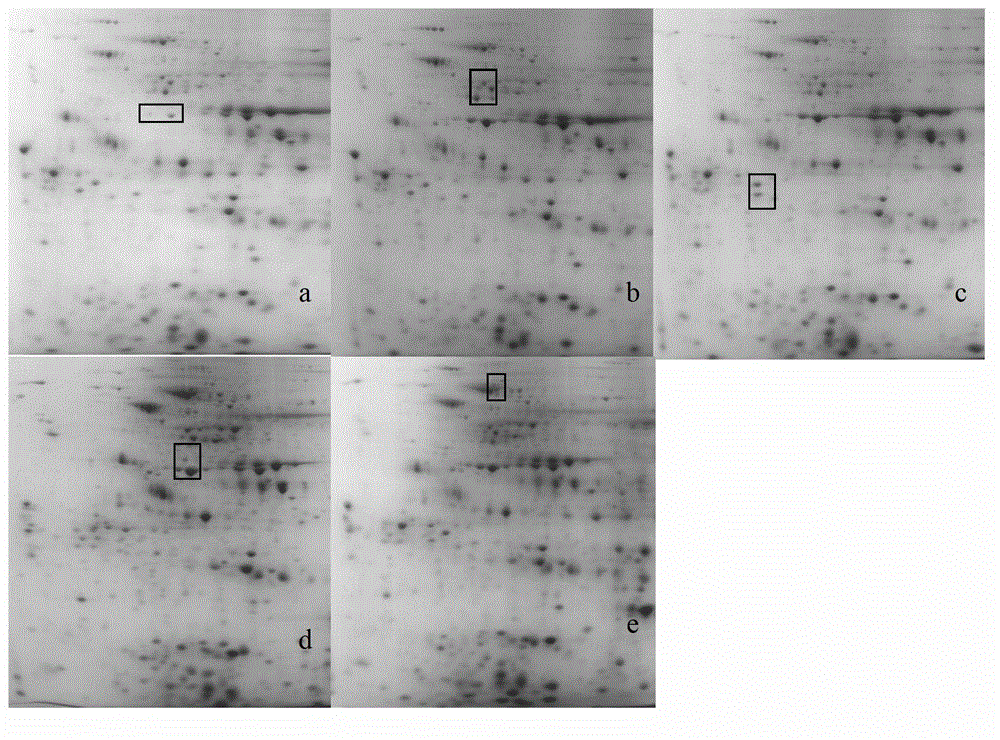Method for identification of barley varieties by two-dimensional electrophoresis technology
A two-dimensional electrophoresis and barley technology, applied in the direction of material analysis, measuring devices, instruments, etc. by electromagnetic means, can solve the problems of difficult identification, difficult application, high identification cost, etc., and achieve the effect of obvious accuracy and stability
- Summary
- Abstract
- Description
- Claims
- Application Information
AI Technical Summary
Problems solved by technology
Method used
Image
Examples
Embodiment 1
[0030] Embodiment one, identification of several barley varieties
[0031] The first step, protein extraction:
[0032] Five kinds of purebred barley (Ganpi No. 4, Ganpi No. 7, Kenmai No. 7, Xiyin No. 1, and Dan No. 2) were manually peeled and ground with liquid nitrogen, and 0.3 g of the sample was added to 0.9 mL of the extract solution at room temperature Extracted for 2h, centrifuged at 10000g for 10min. Take the supernatant and add an equal volume of pH8.8 Tris to balance phenol, extract at room temperature for 30 minutes, and centrifuge at 10000 g for 10 minutes. Add 4 times the volume of cleaning solution A to the phenol phase, extract at -80°C for 3 hours, and centrifuge at 10,000 g for 10 minutes. The protein obtained by centrifugation was washed with cleaning solution A and cleaning solution B respectively, centrifuged three times, and freeze-dried. The dry powder of the obtained whole protein sample was added to 100 μL of lysate, lysed by vortexing at room temper...
Embodiment 2
[0043] Embodiment two, Ganpi No. 6 identification
[0044] The first step, protein extraction:
[0045] The pure-bred barley Ganbe No. 6 was manually peeled and then ground with liquid nitrogen. 0.3 g of the sample was added to 0.9 mL of extract solution for extraction at room temperature for 2 h, and centrifuged at 10,000 g for 10 min. Take the supernatant and add an equal volume of pH8.8 Tris to balance phenol, extract at room temperature for 30 minutes, and centrifuge at 10000 g for 10 minutes. Add 4 times the volume of cleaning solution A to the phenol phase, extract at -80°C for 3 hours, and centrifuge at 10,000 g for 10 minutes. The protein obtained by centrifugation was washed with cleaning solution A and cleaning solution B respectively, centrifuged 3 times, and freeze-dried. The dry powder of the obtained whole protein sample was added to 100 μL of lysate, lysed by vortexing at room temperature for 1 hour, and lysed overnight at 4°C. Centrifuge at 13000ppm at 4°C f...
Embodiment 3
[0053] Example 3, Ganpi No. 4 barley inspection
[0054] The first step, protein extraction:
[0055] The pure-bred barley Ganbeer No. 4 was manually peeled and ground with liquid nitrogen. 0.3 g of the sample was added to 0.9 mL of extract solution for extraction at room temperature for 2 h, and centrifuged at 10,000 g for 10 min. Take the supernatant and add an equal volume of pH8.8 Tris to balance phenol, extract at room temperature for 30 minutes, and centrifuge at 10000 g for 10 minutes. Add 4 times the volume of cleaning solution A to the phenol phase, extract at -80°C for 3 hours, and centrifuge at 10,000 g for 10 minutes. The protein obtained by centrifugation was washed with cleaning solution A and cleaning solution B respectively, centrifuged 3 times, and freeze-dried. The dry powder of the obtained whole protein sample was added to 100 μL of lysate, lysed by vortexing at room temperature for 1 hour, and lysed overnight at 4°C. Centrifuge at 13000ppm at 4°C for 10...
PUM
 Login to View More
Login to View More Abstract
Description
Claims
Application Information
 Login to View More
Login to View More - R&D
- Intellectual Property
- Life Sciences
- Materials
- Tech Scout
- Unparalleled Data Quality
- Higher Quality Content
- 60% Fewer Hallucinations
Browse by: Latest US Patents, China's latest patents, Technical Efficacy Thesaurus, Application Domain, Technology Topic, Popular Technical Reports.
© 2025 PatSnap. All rights reserved.Legal|Privacy policy|Modern Slavery Act Transparency Statement|Sitemap|About US| Contact US: help@patsnap.com



